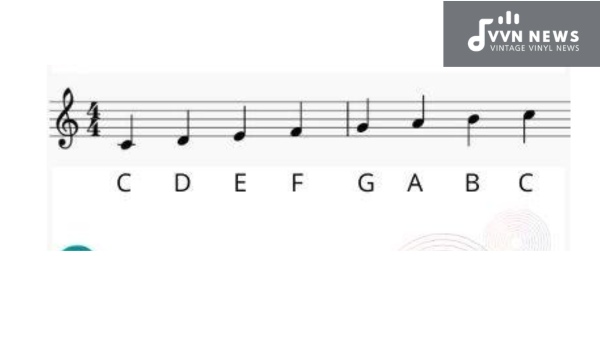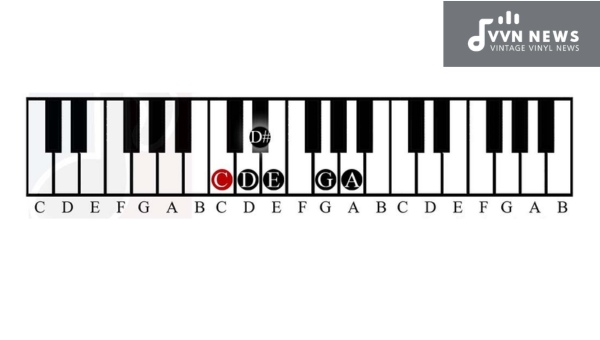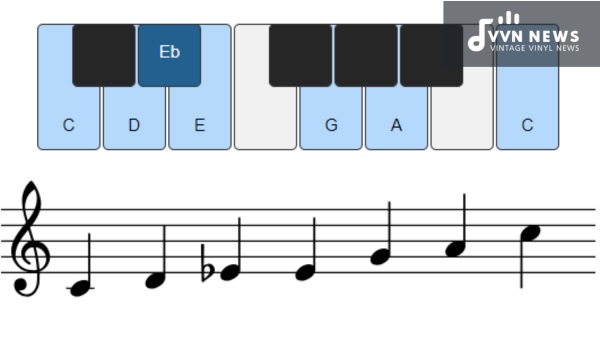The C Major Blues Scale is a captivating musical tool that strikes a balance between the upbeat, bright sound of the major scale and the soulful, expressive nuances found in blues music.
As someone who loves delving into the intricacies of musical scales and their applications, I find that this particular scale illustrates just how versatile and evocative a few notes can be when played with feeling and intention.
It’s a favorite among guitarists and pianists alike, often serving as a stepping stone for musicians aiming to add some bluesy flair to their playing.
Whether you’re jamming with friends or working on your solo skills, getting familiar with the C Major Blues Scale is an excellent way to expand your repertoire.
So, let me guide you through its aspects and practical uses so you can weave this colorful sonic thread into your own music tapestry.
Elements of C Major Blues Scale
The C Major Blues Scale is a hexatonic scale, which means it comprises six distinct notes.
To construct it, you start with the familiar C major pentatonic scale—C, D, E, G, A—and then add a crucial bluesy twist: the flat third (♭3), known as the blue note. This gives us Eb. Here is a breakdown:
- Root (R): C
- Major Second (2nd): D
- Minor Third (♭3): Eb
- Major Third (3rd): E
- Perfect Fifth (5th): G
- Major Sixth (6th): A
These elements blend to give the scale its characteristic major-blues sound—joyful yet tinged with melancholy.
Different C Major Blues Scale Shapes

Learning the C Major Blues Scale isn’t just about memorizing notes; it’s about understanding the different shapes that allow you to play the scale across the entire fretboard of your instrument.
By mastering these shapes, you can unlock new creative potential and enhance your improvisational skills.
Here are five distinct shapes that will help you grasp the C Major Blues Scale’s versatility.
Also Read: A Sharp Minor Pentatonic Scale [Unique Harmonic Possibilities]
Shape 1: The Open Position
The open position is often the first shape a beginner learns. Here, you utilize open strings combined with fretted notes on the lower frets:
- E string: Open, 2nd fret
- A string: Open, 1st fret, 2nd fret
- D string: Open, 2nd fret
This shape gives you a foundation and helps acclimate your fingers to the most accessible form of the scale.
Shape 2: The Box Pattern
Moving up the neck, we encounter what’s affectionately known as “the box pattern.”
This shape is favored for its ease of use during solos and is typically found starting at the third or fifth fret:
- E string: 3rd fret, 5th fret
- A string: 3rd fret, note on 5th
- D string: Same pattern
The symmetry here makes it a comfortable shape to begin with when exploring solo options.
Shape 3: Middle Neck Spread
In this shape, you’ll spread out across a wider span of frets and start integrating more strings:
- Located around the seventh to tenth frets.
- Involves stretching fingers further apart for reach.
This form challenges dexterity but also unlocks melodic movement within your playing.
Also Read: D Major: The Scales And Chords [Broaden Your Musical Vocabulary]
Shape 4: Upper Neck Extension
Here we transition into higher octave tones:
- Dominates around the twelfth fret area.
- Expressive for high-energy licks and runs.
Playing in this range brings clarity and brightness to melodies that can lift any bluesy tune.
Shape 5: The Entire Neck
The final stage is connecting all previous shapes into a comprehensive overlay of the entire neck:
- Use positions one through four as waypoints.
- Forge fluid transitions between octaves.
By internalizing all five shapes of the C Major Blues Scale in their unique areas on the neck.
You’ll have a full palette of musical colors at your fingertips—enabling dynamic lead lines no matter where your hand lands on your instrument.
Relative Notes in C Major Blues Scale
When exploring the C Major Blues Scale, it’s essential to comprehend its relationship to both the major and minor scales.
This scale is a variation of the C major pentatonic scale with an added blues note. The notes of this distinctive scale are C, D, E♭, E, G, and A.
Here is how it lines up with the corresponding major and minor scales:
- The C Major Scale consists of C, D, E, F, G, A, and B. When we compare it to the blues scale, we notice that only F and B are omitted but a bluesy E♭ (the flat third) is added.
- Relating to the C Minor Pentatonic, which includes C, E♭, F, G, and B♭ as its notes; you can observe that by changing B♭ to A (the major sixth), it mirrors four out of six notes from our Blues Scale.
By recognizing these connections between scales:
- You hone your ability to transition smoothly between blues inflections and more traditional sounds within a piece.
- It boosts your improvisational skills by widening your musical vocabulary.
Discovering the nuances of how the C Major Blues Scale correlates with these fundamental scales enriches your musical understanding and creates a bridge toward more complex harmonic exploration.
Also Read: E Major: Scale And Chords [Exciting Sounds For Your Compositions]
C Major Blues Practice Tracks

When delving into the world of blues, practice tracks become an indispensable tool for honing your skills.
For those focusing on the C Major Blues Scale, selecting a variety of backing tracks that span different tempos and styles can significantly enhance your ability to improvise and express emotion through music.
Slow Blues: A slow blues backing track in the key of C allows you to explore each note’s expressive potential deeply.
It gives you ample room to bend strings, experiment with vibrato, and let each note resonate. This slower pace suits emotional play and really lets the nuances of the C Major Blues Scale shine.
- Shuffle Groove: A groove-based shuffle in C can add a bit of bounce to your playing. This kind of track typically has a swinging rhythm that can inspire syncopated phrasing and playful interaction with the beat.
- Funk Blues: For a more contemporary feel, consider practicing with a funk-blues track. The groove here is more pronounced, encouraging staccato playing and rhythmic precision. Funk-blue tracks often have complex drum patterns or bass lines that provide interesting rhythmic counterpoints to practice against.
To find these tracks, simply search for “C Major Blues backing track” followed by your desired style (e.g., slow blues, shuffle, funk) on platforms like YouTube or music services like Spotify. You can quickly locate an array of practice tracks tailored to different moods and levels of complexity.
Also Read: C Sharp Major Pentatonic Scale [Crisp & Clear Tones For Your Music]
The Value of Ear Training for Major Blues Scales
Ear training is pivotal when it comes to mastering the Major Blues scale; it is the cornerstone that brings musical theory and practice together. Here are the key points highlighting its value:
- Identify Intervals: Understanding the sonic distance between notes, or intervals, within the scale helps you anticipate the emotional impact of a melody.
- Improvise with Confidence: Train your ear to recognize these intervals and you’ll find yourself improvising with much more confidence.
- Transcription Skills: By honing your ear, transcribing your favorite blues solos becomes more intuitive. This skill is invaluable for learning and analysis.
- Communicate Musically: Ear training enables you to understand and communicate ideas more effectively with fellow musicians during jams or performances.
Developing a good ear allows musicians to internalize the characteristic sounds of the C Major Blues Scale, making it easier to apply creatively in their playing.
Hit Songs Featuring Major Blues Scales

When it comes to iconic tunes that have effectively utilized the Major Blues Scale, several classics immediately spring to mind.
These songs have not only stood the test of time but also serve as perfect studies of how the blues scale can be incorporated into various genres and styles. Here are a few notable examples:
- “Sweet Home Chicago” by Robert Johnson – This blues staple makes use of the major blues scale throughout its catchy melody and solos. Its influence remains significant in blues music and beyond.
- “Sunshine of Your Love” by Cream – The riff that defines this rock anthem is built around the major blues scale, showcasing its cross-genre versatility.
- “Rock And Roll” by Led Zeppelin – Here, the major blues scale makes a lively entrance, steering the song with its infectious energy and classic rock ‘n’ roll vibe.
Each of these tracks highlights how integral the Major Blues Scale is across musical landscapes.
By studying these songs, you get a broader understanding of how to apply this simple yet expressive scale creatively.
Whether it’s through dissecting each note or improvising over practice tracks that mimic these styles, embracing these hit tunes can accelerate your musical journey into mastering the C Major Blues Scale.
C Major Blues’ Genre Influence
The C Major Blues Scale has subtly permeated numerous genres, shaping the soundscapes of countless classic tunes.
Originally rooted in African-American folk music, the blues scale lent its soul-stirring qualities to the genre of blues, which in turn became a cornerstone for rock and roll.
As the scale made its journey through different eras, it adapted to the changing musical landscapes.
Notably, jazz musicians weaved this scale into their improvisations, exploiting its hybrid nature to create a blend of major tonality with that ‘bluesy’ feel.
Artists like Miles Davis often turned to this scale for its simplicity and emotional depth.
In rock music, legends such as Chuck Berry and Elvis Presley injected the rockabilly vibe with a touch of blues scale magic.
Beyond these styles, even country music has found a friend in the C Major Blues Scale, employing it to give songs a touch of warmth and grit.
Meanwhile, contemporary pop artists occasionally dip into this palette for subtle nuances and echoes of vintage charm.
In modern musical practice, understanding this scale’s influence across genres equips you with a versatile tool.
It allows you to converse across musical dialects—be it blues’ heartfelt laments or rock’s electrifying solos—with fluency and authenticity.
Recognizing how the C Major Blues Scale enriches diverse genres empowers you to craft compelling new narratives in your own playing or songwriting.
Also Read: G Flat Minor Triad [Mastering Complex Guitar Chords]
FAQs About the C Major Blues Scale
What notes make up the C Major Blues Scale?
The C Major Blues Scale consists of the notes C, E, G, A, and B♭, with the addition of a flattened third, E♭, for that bluesy feel.
Can I use the C Major Blues Scale over any chord progression in C major?
Yes, you can use it over a C major chord progression, but listen for tension with certain chords and adjust your phrasing accordingly.
How is the C Major Blues Scale different from the traditional blues scale?
Unlike the minor blues scale, which has a darker quality, the C Major Blues Scale incorporates major intervals for a brighter and happier blues sound.
Are there any iconic songs that feature the C Major Blues Scale prominently?
Many classic rock and blues songs utilize this scale; one example is “Sweet Home Chicago”, which often incorporates major blues scale elements.
Is it necessary to learn the C Major Blues Scale to play blues music?
While not strictly necessary, learning this scale adds depth and versatility to your improvisation skills in blues music.
Conclusion
In wrapping up our exploration of the C Major Blues Scale, it’s clear that mastery of this scale can significantly enrich your musical expression.
It serves as an essential tool for improvisation, allowing musicians to navigate the space between joyous major tonalities and the heartfelt depths of the blues.
Embrace this scale, practice diligently, and you’ll soon find your own voice within its timeless sound.








